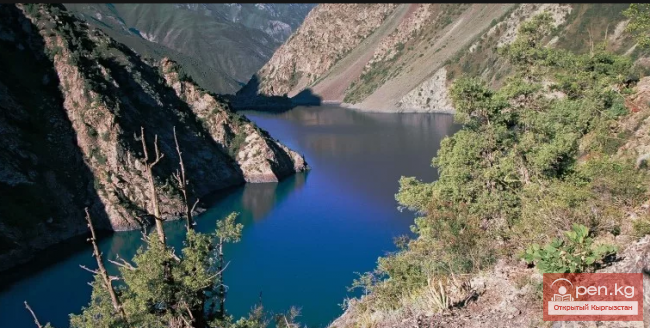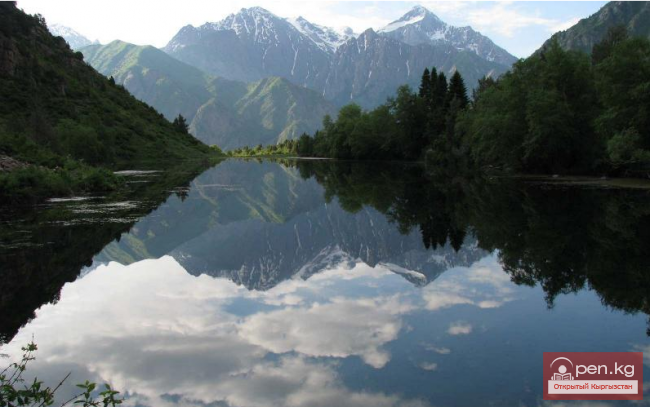
Geographical Information: Lake Kara-Suu is located in the area of the Taktalyk ridge, at the lower...

Lake Kapka-Tash (local residents call it Kol-bashi, which translates to "Source, beginning...

Lake Suttyu-Bulak or "Milk Lake" The lake is located in the "Semenovskoye"...

Geographical Information: The lake is located in the Naryn region, Ak-Sai valley, on the border...
Sary-Chelek Lake. Sary-Chelek Lake ("yellow bowl" in translation from Kyrgyz) is located...

Moon Lake On the northern slope of the Turkestan Range lies Lake Ai-Köl, which translates to...

Geographical Information: Song-Kul (possible variants of Russian spelling: СОНКЁЛЬ, Сонг-Кёль,...

Geographical information: Chatyr-Kul (Chatyr-Köl) is a closed lake in the Central Tien Shan,...

One of the most beautiful lakes in Kyrgyzstan - the dead lake Kël-Tor It is located in the gorge...

Lake Köl-Suu translates as "coming water" The lake is located in the Naryn region,...

Geographical Information: An astonishingly beautiful corner of nature in southern Kyrgyzstan at an...

Jasyl-Kel - "Emerald Lake". "Jasyl-Kol Lake - 'a diamond in a mountain...

“Chatyr-Kul” translates from Kyrgyz as “Heavenly Lake.” The high-altitude lake Chatyr-Kul is...

Geographical information: Lake Ekyrgenkol is located in the Barskoon Gorge, in the Issyk-Kul...

Lake Teshik-Kul (also Teshik-Köl) — is a hard-to-reach high-altitude lake It is located at an...

Lake Köl-Ukök is the perfect place to escape from civilization Lake Köl-Ukök, located in the Naryn...

Petrova Lake — the Source of Naryn This is the largest moraine-glacial lake in the Tian Shan by...

Geographical Reference: Toktogul Reservoir is formed by the dam of the Toktogul Hydroelectric...

Geographical Reference: Ala-Kul (Ala-Kyol, Alakul, Alaköl) is a closed lake in the Terkey-Alatau...

In the territory of Kyrgyzstan, there are 750 lakes, reservoirs, and small ponds with a total area...

The "Kyzyl-Unkyur" Zone is located 15 km northeast of the village of Arslanbap in the...

Kulung - "foal" The Kulung and Kulung Minor lakes are a group of lakes, enchanting with...

The "Kara-Suu" Zone is located in the eastern part of the southern slope of the Chatkal...

Sary-Chelek Zone ("yellow bowl") territorially coincides with the basin of the Khoja-Ata...

Jidalyk - "breast berry" Jidalyk (Zhiydeli) is a famous lake in Kadamjay. It is a...

Zone "Isfayram-Sai". The left tributary of the Isfayram-Sai River is the Surme-Tash...

Kara-Archa Waterfall - left tributary of Kegety (Chui region) Coordinates: 42.504977, 75.069273...

Diving at Song-Kul is possible. There is a normal dirt road leading to the lake. Access to the...

Son-Kul. Naryn Region. Before ascending to Lake Son-Kul, just before the 38 Parrots Pass, you can...

How Lake Issyk-Kul Came to Be Many legends have been woven by the people about how Lake Issyk-Kul...

Geographical Reference: In the eastern part of Kyrgyzstan, where the northern and southern arcs of...

The Orto-Tokoy Zone encompasses the territorial foothills at the western end of the Terskey...

"Kokuy-Kul" Among the high mountains lies a small but very deep lake called Kokuy-Kul....
Issyk-Kul - the Mountain Pearl. The most beautiful and largest lake in Central Asia is Lake...
The Kegety Gorge is located 75 km from Bishkek on the northern slopes of the Kyrgyz Ridge and is...

There are relatively few lakes in the Chui Valley and its mountainous surroundings, and all of...

Archaeologists have found the grave of the apostle Matthew at the bottom of Lake Issyk-Kul Diving...

Lake Saz-Kel — "swampy lake". This small but very picturesque lake in Kyrgyzstan...

Grigorievskoe Gorge is one of the wonderful and picturesque natural attractions Chon Ak-Suu Gorge,...

Kara-Kulja Village is the center of the eponymous district Karakulja (archaic: Kara-Kulja; at the...

Small Naryn encompasses the valley of the river of the same name, located between the ridges of...
The high-altitude lake Son-Kul is one of the wonders of the Tian Shan. Here, on the shore of a...

Rocky Canyons of the Kok-Kiya Valley Kyrgyzstan is rich in beautiful and unique places. In the...

Karakulja The Chatkal River in its upper reaches is called Karakulja (translated - Black Ram),...

Picturesque Chichkan Gorge In the tourist center of Central Asia – Kyrgyzstan, there are many...

Another one of the most beautiful gorges in Kyrgyzstan, Kegety Gorge is located on the northern...

Established in 1959, covering an area of 23,868 hectares, it includes unique nut forests and...

Naryn...